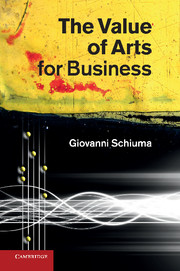Book contents
- Frontmatter
- Contents
- List of figures
- List of boxes
- Acknowledgements
- Foreword
- Introduction
- 1 Why arts matter in management
- 2 The arts into action: Arts-based Initiatives
- 3 The value of Arts-based Initiatives in business
- 4 Arts-based Initiatives and business performance
- 5 Managing Arts-based Initiatives to improve business performance
- A closing remark
- Appendix
- Notes
- References
- Index
1 - Why arts matter in management
Published online by Cambridge University Press: 05 July 2011
- Frontmatter
- Contents
- List of figures
- List of boxes
- Acknowledgements
- Foreword
- Introduction
- 1 Why arts matter in management
- 2 The arts into action: Arts-based Initiatives
- 3 The value of Arts-based Initiatives in business
- 4 Arts-based Initiatives and business performance
- 5 Managing Arts-based Initiatives to improve business performance
- A closing remark
- Appendix
- Notes
- References
- Index
Summary
Introduction
Without a doubt, the arts represent one of the most important knowledge domains for the expression of human feelings and values. They are the product of human civilisations and an essential instrument in shaping culture and society. Indeed, people's lives and communities are entrenched in the arts: they play a fundamental role in shaping and conveying human emotions and a community's values and culture (Guss, 1989). Through the arts people can express and communicate what matters most to them. Mankind's history is tied to the arts. The use of the arts has accompanied the evolution of organisations. Kings and queens, emperors, dictators, politicians and leaders have used the power of the arts to manipulate organisational reality at macro and micro levels, and to affect people's experiences and behaviours.
In acknowledging the importance of the arts in human life, it is worth reflecting on the role and relevance of the use of the arts in management. The arts as a cornerstone of human life provides a vehicle that can inspire and improve today's management discipline and practice (Adler, 2006; Darsø, 2004; Taylor and Ladkin, 2009). From an instrumental and a utilitarian point of view, the arts can support and drive the development of organisational value-creation capacity and in turn improve business performance. The arts represent a knowledge ‘mine’ – rich in ideas, techniques, artistic know-how, products and processes – that can be used to define and adopt innovative managerial models and techniques that are more suited to governing organisational value-creation in the twenty-first century business landscape (Austin and Devin, 2003; Nissley, 2010).
- Type
- Chapter
- Information
- The Value of Arts for Business , pp. 8 - 44Publisher: Cambridge University PressPrint publication year: 2011



